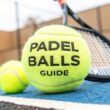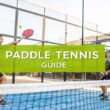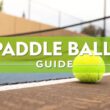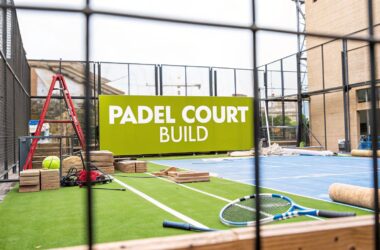In the fast-paced world of padel, speed isn't just an advantage; it's a fundamental requirement. From explosive sprints to the net to rapid lateral movements covering the glass walls, superior speed distinguishes good players from great ones. Many players focus solely on technique, neglecting the physical foundation that truly unlocks their potential on the court. While general fitness has its place, it often fails to address the specific, multi-directional demands of padel. This guide cuts through the noise and delivers exactly what you need.
We will break down eight highly effective, padel-centric drills to improve speed, each designed to enhance your acceleration, agility, and overall on-court quickness. Each drill is detailed with specific sets, repetitions, and expert tips to ensure you are training not just harder, but smarter. These exercises go beyond simple running by targeting the mechanics of explosive movement essential for the game. For a broader understanding of the underlying principles and various training approaches, exploring strategies to run faster and longer can provide a comprehensive foundation for your endurance and pace. Prepare to transform your game, one explosive step at a time.
1. The Padel 'X' Drill: Mastering Court Coverage
The Padel 'X' Drill is a cornerstone exercise for developing court-specific speed and agility, making it one of the most effective drills to improve speed in your game. It simulates the four critical movements in padel: forward to the net, diagonally back to defend a lob, across to the side wall, and back to the center 'T'. By tracing an 'X' pattern from the back of the court to the net and side walls, you train your body to execute the explosive starts, stops, and changes of direction required during a high-intensity rally.
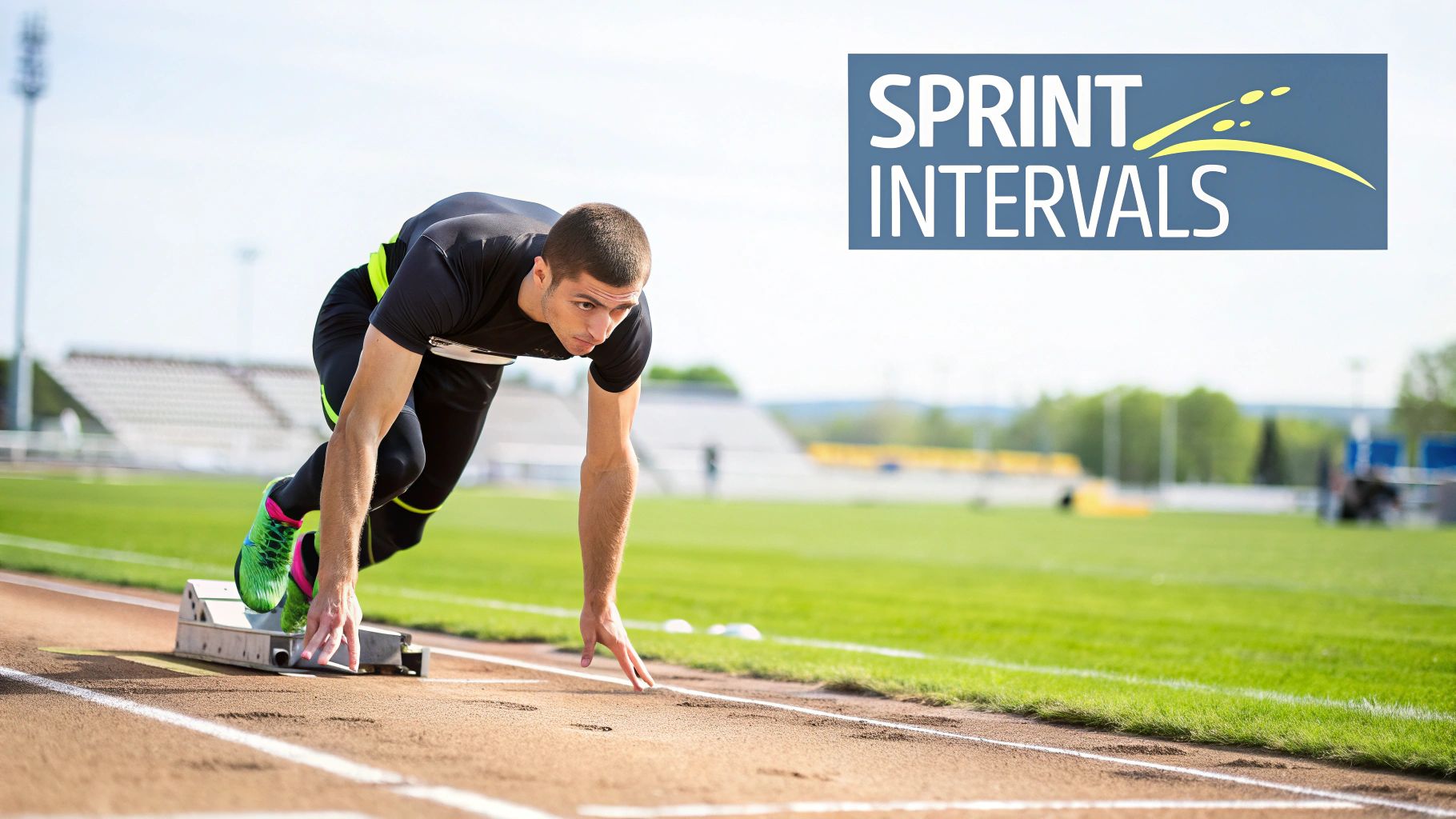
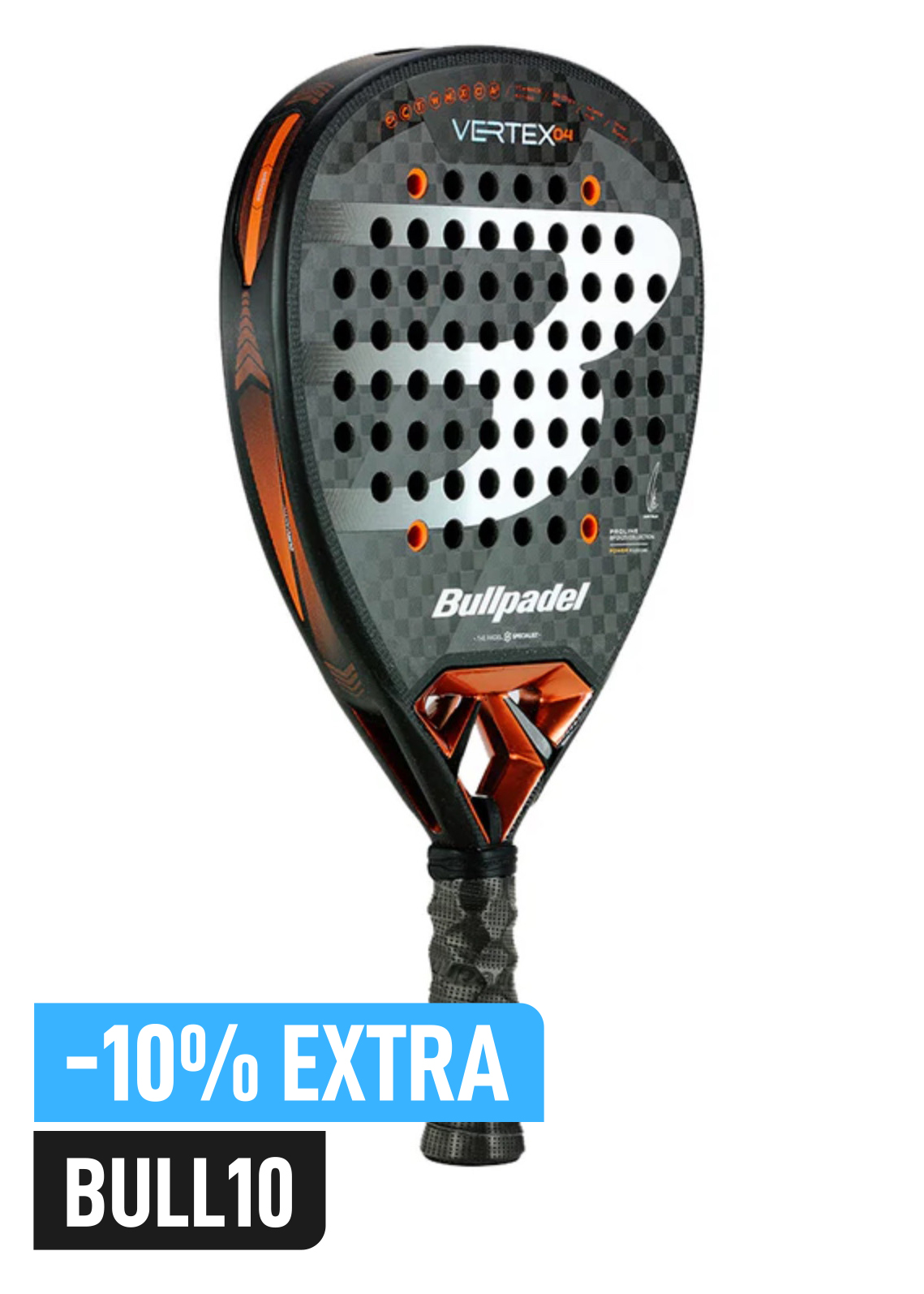
Buy the best padel gear to level up your next game!
CHECK OUT this deal from Padel Market!Get ready to take your game to the next level with the latest padel gear from Padel Market! Fast EU and Worldwide Shipping
This drill isn't just about running; it's about efficient, purposeful movement that directly translates to better court positioning and quicker reactions. Regular practice builds the muscle memory needed to move instinctively, ensuring you're always in the right place at the right time.
How to Execute the 'X' Drill
The setup is simple. You only need one side of the padel court. Start at the 'T' intersection of the service lines.
- Forward Sprint: Sprint forward to the left net post.
- Diagonal Retreat: Shuffle backward diagonally to the right back corner (near the glass).
- Forward Sprint: Sprint forward from the back corner to the right net post.
- Diagonal Retreat: Shuffle backward diagonally to the left back corner.
This completes one 'X'. The goal is fluid, rapid transitions between points. For instance, coaches use this drill to diagnose weaknesses in a player's movement, such as a slow retreat for a bandeja or a hesitant approach to the net.
Actionable Tips for Maximum Impact
To get the most out of this drill, focus on technique over raw speed initially.
- Start at 70% Intensity: Perfect the movement pattern and footwork before pushing your pace.
- Stay Low: Maintain a low center of gravity with a wide base, especially during direction changes, to stay balanced and explosive.
- Racket Ready: Keep your racket up in the "ready" position throughout the entire drill to simulate real match conditions.
Workout Protocol: Perform 3-5 sets, where one set is a complete 'X' pattern. Rest for 60-90 seconds between each set to ensure you can maintain high intensity and proper form.
2. Plyometric Bounds and Hops: Building Explosive Power
Plyometric training is a powerful method for enhancing raw athletic power, making it one of the most fundamental drills to improve speed off the court. These exercises involve explosive movements like jumping and bounding, which train your muscles to produce maximum force in minimum time. By rapidly stretching and contracting your muscles, plyometrics develop a reactive strength that directly translates to a quicker first step, higher vertical leap for smashes, and more powerful lateral movements on the padel court.
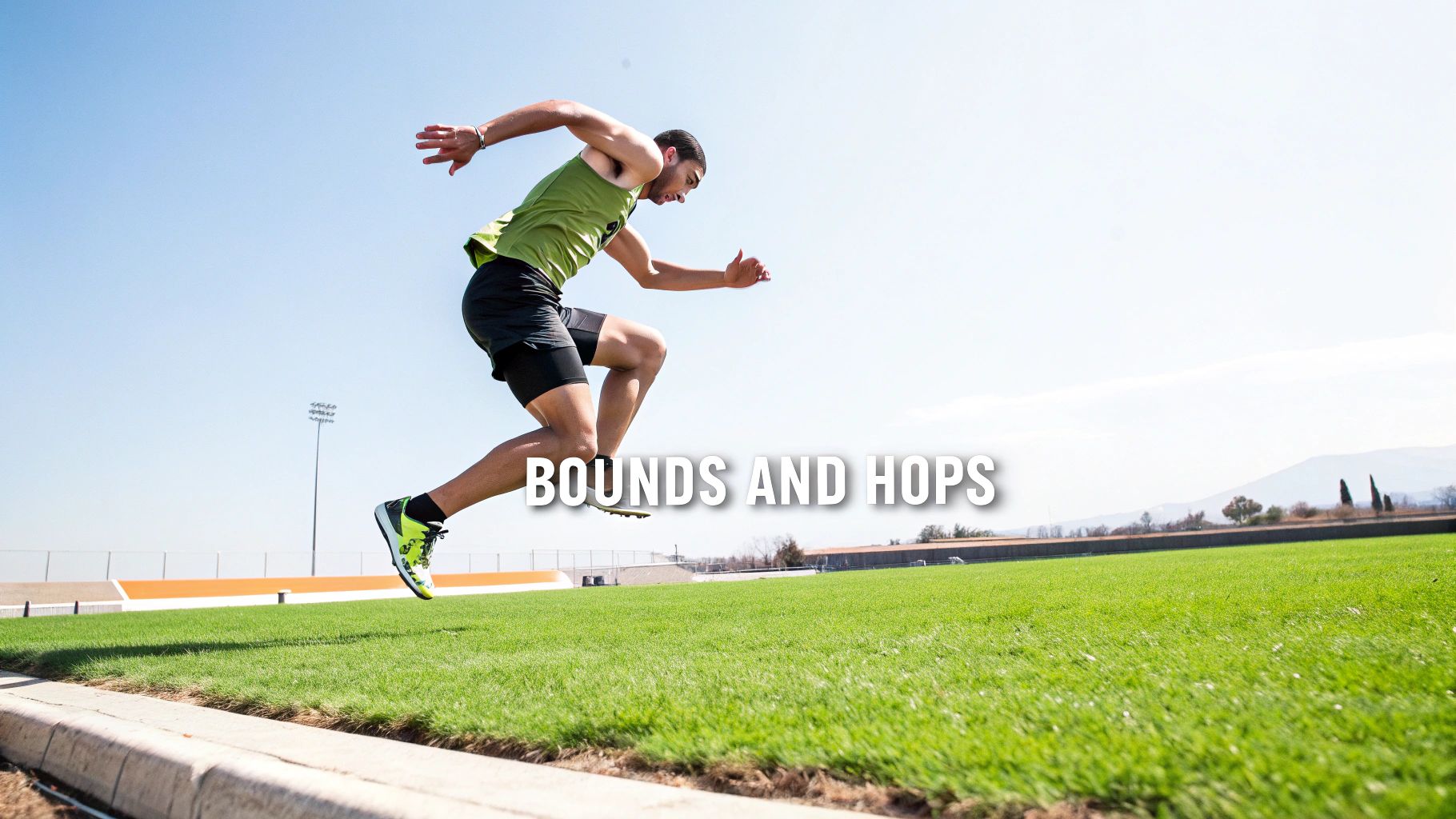
This form of training, pioneered by Soviet sports scientist Yuri Verkhoshansky, conditions the nervous system to fire muscle fibers more rapidly. The result is an athlete who can accelerate, decelerate, and change direction with far greater efficiency, crucial for reacting to fast-paced volleys and defending tricky shots.
How to Execute Plyometric Bounds and Hops
These exercises require no equipment and focus on generating maximal power from the ground up. Start with basic movements and progress as you build strength and control.
- Double-Leg Hops: Hop forward consecutively, focusing on spending as little time on the ground as possible.
- Single-Leg Bounds: Bound from one leg to the other, covering as much distance as you can with each jump.
- Lateral Bounds: Jump from side to side, landing on the outside leg and immediately exploding back in the opposite direction.
The goal is quality over quantity. Every repetition should be performed with maximum intent and perfect form to train the explosive pathways effectively.
Actionable Tips for Maximum Impact
Proper execution and programming are critical to prevent injury and reap the benefits of plyometrics.
- Build a Foundation First: Ensure you have a solid strength base from exercises like squats and lunges before starting plyometrics.
- Focus on Landing: Land softly and absorb the impact through your hips and knees to protect your joints.
- Keep Reps Low: High-quality, low-volume sets are key. Aim for maximum effort on every jump.
Workout Protocol: Perform 2-3 sets of 5-8 repetitions per exercise. Allow at least 48-72 hours of recovery between plyometric sessions to allow your nervous system and muscles to fully recover.
3. Acceleration Ladder Drills: Building Explosive Power
Acceleration Ladder Drills are a fundamental tool for enhancing raw, linear speed, making them one of the most powerful drills to improve speed for any padel player. This method focuses on the critical first few steps, training your body to generate maximum force and reach top velocity as quickly as possible. It involves sprinting through progressively longer marked distances, forcing you to build and sustain momentum, which is vital for chasing down smashes or attacking a short ball.
This drill isn't about endurance; it's about pure, explosive power. By focusing on the mechanics of acceleration, you teach your neuromuscular system to fire more efficiently, translating directly into faster court coverage. Elite track coaches and NFL combine trainers use this exact principle to shave milliseconds off sprint times.
How to Execute Acceleration Ladder Drills
The setup requires an open space and cones or markers. The standard setup uses distances of 10, 20, and 30 meters from a starting line.

Buy the best padel gear to level up your next game!
CHECK OUT this deal from Padel Market!Get ready to take your game to the next level with the latest padel gear from Padel Market! Fast EU and Worldwide Shipping
- First Gear (0-10m): Explode from the starting line, focusing on a powerful forward lean and driving your knees.
- Second Gear (10-20m): As you cross the 10m mark, transition to a more upright posture and increase your stride frequency.
- Third Gear (20-30m): At the 20m mark, aim to hit your maximum velocity, maintaining form and powerful arm action through the final cone.
The goal is a seamless "gear shift" between each segment. The distinction between this and simple sprints lies in the conscious effort to build speed incrementally, which improves your body's acceleration curve.
Actionable Tips for Maximum Impact
To get the most out of acceleration ladders, technique is paramount.
- Focus on the First Step: The drill begins before you even move. Practice an explosive start from a static, athletic stance.
- Full Recovery: Walk back to the start after each repetition. This is a power drill, not a conditioning one, so full recovery ensures maximum intensity on every sprint.
- Arm Action is Key: Drive your elbows back forcefully to generate momentum and counterbalance your leg drive.
Workout Protocol: Perform 4-6 sets (one set is a full 0-30m sprint). Rest completely between each set by slowly walking back to the starting line. This ensures each repetition is performed at 100% effort. For a deeper dive into complementary exercises, you can explore more about change of direction drills.
4. Resistance Running (Weighted Vests and Sleds)
Resistance running is an advanced training method that enhances explosive power, making it one of the most potent drills to improve speed for serious padel players. By adding external resistance, either through a weighted vest or by pulling a sled, you force your leg and core muscles to generate significantly more force with each stride. This overload stimulus builds strength directly within the specific movement pattern of sprinting.
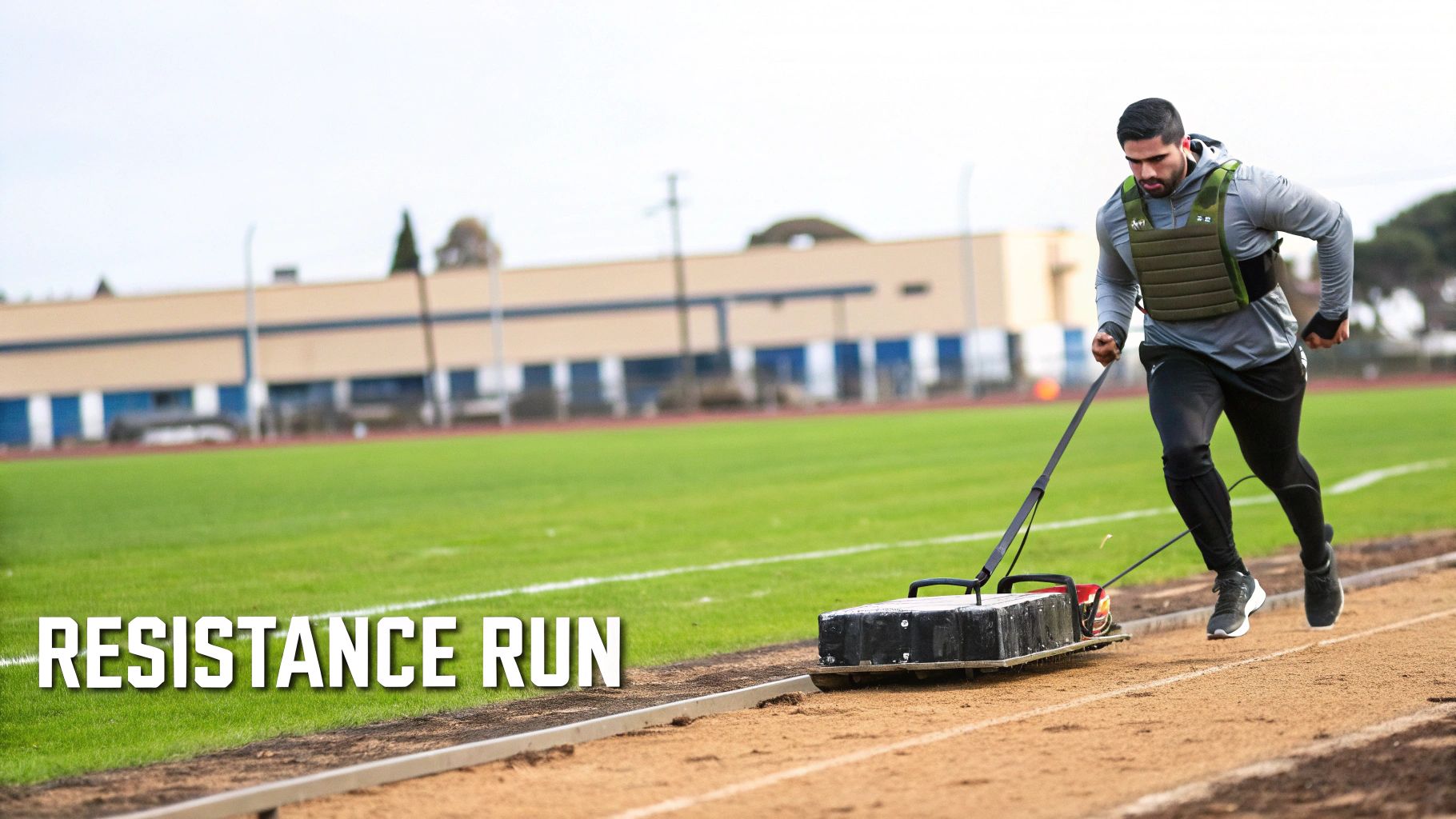
This technique leverages a principle called post-activation potentiation (PAP). After performing a heavy resisted sprint, your nervous system is "primed," allowing for a more powerful and faster contraction on subsequent unweighted sprints. This contrast training is used by elite athletes, from NFL players doing sled pushes to collegiate track programs, to bridge the gap between strength and on-court speed.
How to Execute Resistance Running
The application is straightforward but requires strict attention to form. The goal is to add just enough weight to challenge your muscles without compromising your running mechanics.
- Warm-up Thoroughly: Perform a dynamic warm-up focusing on your hips, hamstrings, and ankles.
- Resisted Sprints: Put on a weighted vest or harness connected to a sled. Sprint for 15-20 meters, focusing on driving your knees and maintaining a powerful arm swing.
- Remove Resistance: Immediately after the weighted sprint, remove the vest or unclip the harness.
- Unweighted Sprints: Perform an unweighted sprint over the same distance, focusing on feeling light and explosive.
This contrast is where the magic happens. The body, accustomed to the heavy load, overcompensates on the unweighted sprint, resulting in a faster, more powerful movement.
Actionable Tips for Maximum Impact
To safely and effectively integrate this drill, prioritize form and progressive overload.
- Limit Resistance: Start with a load that is no more than 10-15% of your body weight to avoid altering your sprint biomechanics.
- Maintain Proper Posture: Keep your chest up and core engaged. If your form breaks down, the weight is too heavy.
- Focus on Contrast: Always follow a resisted set with 1-2 unweighted sprints to capitalize on the PAP effect.
Workout Protocol: Perform 4-6 sets of one resisted sprint followed by one unweighted sprint. Rest for 2-3 minutes between sets to allow for full nervous system recovery and maximum effort on each repetition.
5. In-Place High Knees and Marching Drills: Building Explosive Leg Drive
In-place High Knees and Marching Drills are foundational exercises that serve as some of the most accessible drills to improve speed. By focusing on rapid leg turnover and powerful hip flexion, these exercises directly train the neuromuscular pathways responsible for acceleration. High knees involve driving the knee up toward the chest, while marching drills execute the same motion at a more controlled tempo, perfecting form and muscle activation.
This type of drill is less about court coverage and more about the fundamental mechanics of sprinting. It enhances cadence, strengthens hip flexors, and improves coordination, which are the building blocks for quicker first steps and faster transitions on the padel court. Athletic coaches universally use these drills as warm-ups and conditioning tools to prepare the body for high-intensity work.
How to Execute High Knees and Marching Drills
The beauty of these drills lies in their simplicity, requiring no equipment and minimal space.
- High Knee March (Controlled): Stand tall with your feet hip-width apart. Drive your right knee up towards your chest until your thigh is parallel to the ground, while simultaneously bringing your left arm forward. Lower your leg with control and repeat on the other side.
- High Knees (Explosive): From the same starting position, begin running in place. Focus on driving your knees up to at least hip height as quickly as possible. The goal is to maximize the speed of your leg turnover while minimizing ground contact time.
The distinction is crucial: marching builds strength and form, while high knees develop speed and explosive power. For example, military fitness routines incorporate high knees for conditioning, while soccer programs use marching drills to reinforce proper running mechanics.
Actionable Tips for Maximum Impact
To transform this simple exercise into a powerful speed-building tool, concentrate on precise execution.
- Maintain Upright Posture: Keep your core engaged and your torso straight. Avoid leaning back as you drive your knees up.
- Focus on Knee Height: Consistently drive your knees to hip height to fully engage the hip flexors.
- Use Your Arms: Coordinate your arm swings with your leg movements to generate momentum and maintain balance, just as you would when sprinting.
Workout Protocol: Use as a dynamic warm-up. Perform 3 sets of 30 seconds for each drill (Marching and High Knees). Rest for 30-45 seconds between sets. For more details on protecting your joints during such exercises, you can find information about how to strengthen knees for running.
6. Flying 30s and Flying Starts
While many padel movements are short and sharp, developing your absolute top speed is a critical component that translates into faster court coverage on lobs and wider shots. Flying 30s are one of the most effective drills to improve speed by specifically targeting maximum velocity, a training method borrowed from elite track and field athletes and adapted for court sports. The drill separates acceleration from top speed, allowing you to train your body to operate efficiently at its physical limit.
This exercise involves building up speed over a set distance before sprinting through a timed, shorter "flying" zone. By reaching your maximum velocity before the timed portion begins, you can focus purely on maintaining that top-end speed, which is crucial for chasing down deep lobs or closing the net with explosive quickness.
How to Execute Flying 30s
The setup requires a straight, clear path of at least 50 meters, such as an athletic track or a large open space. You will need cones to mark three distinct zones.
- Acceleration Zone: Mark a starting line and another cone 20-30 meters away. This is your build-up area.
- Flying Zone: From the end of the acceleration zone, mark a 30-meter timed segment. This is your "Flying 30."
- Deceleration Zone: Allow at least 20 meters after the finish line to slow down safely without abrupt stops.
Sprint through the acceleration zone, building up to your maximum speed. As you pass the first cone of the flying zone, maintain that top speed all the way through to the end cone. The goal is to feel relaxed and smooth while moving as fast as possible.
Actionable Tips for Maximum Impact
To truly benefit from this drill and avoid injury, proper execution is key.
- Mark Zones Clearly: Use brightly colored cones to visibly separate the acceleration, flying, and deceleration zones.
- Complete Recovery: This is not a conditioning drill. Rest for at least 2-3 minutes between reps to allow your nervous system to fully recover, ensuring each sprint is at 100% effort.
- Analyze Form: If possible, have someone video record you during the flying zone. This allows you to analyze your running mechanics at maximum velocity and identify areas for improvement.
Workout Protocol: Perform 4-6 repetitions in a single session. This drill is highly intensive, so it should be done when you are fresh, typically after a thorough warm-up and before any skill-based or endurance training.
7. Agility Ladder Footwork Drills
Agility ladder drills are a foundational tool for any athlete, but they are especially critical for padel players looking to enhance their footwork, coordination, and reaction time. These exercises are some of the most versatile drills to improve speed, as they train the neuromuscular system to fire more rapidly. By forcing you to perform precise, quick foot patterns, the ladder improves your ability to accelerate, decelerate, and change direction with explosive efficiency on the court.
This training directly translates to quicker split-steps, faster recovery to the center 'T' after a shot, and more agile movement along the net. Regular practice develops the fast-twitch muscle fibers in your lower legs, which are essential for the short, sharp bursts of speed that define padel rallies.
How to Execute Agility Ladder Drills
The beauty of the agility ladder is its simplicity and versatility. Lay the ladder flat on the court or any suitable surface.
- Ickey Shuffle: A classic lateral movement drill. Step into a square with one foot, followed by the other. Then, step out to the side with the lead foot, moving your body down the ladder.
- Single-Leg Hops: Hop through each square on one leg, focusing on a quick ground contact time. Repeat on the other leg.
- Lateral High-Knees: Move sideways down the ladder, bringing both feet into each square while driving your knees up high.
- In-In-Out-Out: Facing the ladder, step into the first square with both feet (in-in), then step outside the square with both feet (out-out), advancing to the next square.
These patterns are used in elite training programs across sports, from NFL training camps to professional soccer academies, to build a foundation of superior footwork.
Actionable Tips for Maximum Impact
To transform these patterns into meaningful on-court speed, precision is key.
- Focus on 'Quick Feet': The goal is to minimize the time your feet are in contact with the ground. Think "light and fast."
- Use Your Arms: Drive your arms in coordination with your legs to maintain balance and generate momentum.
- Start Fresh: Perform ladder drills at the beginning of your training session when your nervous system is fresh to ensure high-quality repetitions.
Workout Protocol: Perform 3-5 sets of your chosen ladder drill. A set consists of one full pass down the ladder and back. Rest for 45-60 seconds between sets to maintain maximum speed and execution quality. For a deeper dive into different patterns, you can learn more about agility and speed drills on padelrumors.pages.dev.
8. Assisted Running (Downhill and Towing)
Assisted running is an advanced training method that uses external forces like gravity or elastic resistance to help you run faster than your unassisted maximum velocity. This makes it one of the most potent drills to improve speed by reprogramming your neuromuscular system. By sprinting on a slight downhill grade or being gently towed, your body learns to operate at a higher speed, improving stride frequency and neuromuscular coordination.
This "overspeed" training forces your central nervous system to fire signals more rapidly, creating adaptations that carry over to your normal sprints on the court. It's a technique borrowed from elite track and field programs, designed to break through speed plateaus by teaching your body what a new level of fast feels like.
How to Execute Assisted Running
This drill requires specific conditions for safety and effectiveness. It is not a beginner drill and should be approached with caution.
- Downhill Sprints: Find a gentle, smooth slope with a grade of no more than 3-5%. Sprint down the hill for 20-40 meters, focusing on maintaining control and rapid leg turnover. Walk back up to recover.
- Towing (with a partner): Use a resistance band or specialized towing harness. Have a partner stand in front of you and provide a gentle, consistent pull as you sprint for 20-30 meters. The assistance should be light, just enough to increase your speed by a fraction without altering your running mechanics.
Elite track sprinters and professional soccer players often use these methods in their pre-season training to build top-end speed that translates directly to on-field performance.
Actionable Tips for Maximum Impact
Proper execution is critical to avoid injury and maximize benefits. Overspeed training is demanding, so technique and safety must come first.
- Prioritize Safety: Only perform these drills on a safe, even surface. Always have coaching supervision, especially when first attempting towing.
- Don't Overdo It: Limit assisted running to 1-2 sessions per week to prevent overtraining and allow for nervous system recovery.
- Contrast with Unassisted Sprints: Immediately follow an assisted sprint with a regular, unassisted sprint over the same distance. This helps transfer the new motor patterns to your normal running mechanics.
Workout Protocol: Perform 4-6 sets of 30-meter assisted sprints. Rest fully for 2-3 minutes between each repetition to ensure maximal effort and quality of movement. Always complete a thorough warm-up beforehand.
8-Drill Speed Training Comparison
| Method | 🔄 Implementation complexity | ⚡ Resource requirements | ⭐📊 Expected outcomes / Impact | 💡 Ideal use cases & Key advantages |
|---|---|---|---|---|
| Sprint Intervals | High — programming, recovery management | Medium — track/space, timing, recovery time | ⭐⭐⭐⭐ — increases anaerobic power, top speed; measurable gains | Time-efficient for track & field and team sports; high caloric burn; track times to monitor |
| Plyometric Bounds and Hops | Medium — technical, needs strength base | Low — minimal gear, safe surface, optional boxes | ⭐⭐⭐⭐ — improves reactive power, running economy, elasticity | Best for explosive sports (sprints, basketball); quick neural gains; build strength first |
| Acceleration Ladder Drills | Medium — setup and progression planning | Low — cones/tape, measured distances | ⭐⭐⭐ — enhances acceleration mechanics and efficiency | Ideal for technique coaching and acceleration phases; clear benchmarks for progress |
| Resistance Running (Vests & Sleds) | High — load prescription and form monitoring | Medium–High — sleds/vests, space; possible cost | ⭐⭐⭐⭐ — builds running-specific strength; potentiation carryover | Suited to strength–power phases; scale load (10–15% BW) and include contrast sprints |
| In-Place High Knees & Marching | Low — simple to teach; form-focused | Minimal — no equipment, small space | ⭐⭐ — improves cadence, hip-flexor strength; excellent warm-up | Warm-ups and novice conditioning; scalable and low impact; use before intense work |
| Flying 30s & Flying Starts | Medium — requires approach control and timing | Medium — long run-up space, timing/markers | ⭐⭐⭐⭐ — isolates max velocity; accurate speed metrics | Best for max-velocity testing and training; mark zones and allow full recovery |
| Agility Ladder Footwork Drills | Low–Medium — pattern learning and coordination | Low — ladder/cones, small area | ⭐⭐ — improves foot speed, coordination; limited top-speed transfer | Useful for agility, proprioception, and sport-specific footwork; master basics first |
| Assisted Running (Downhill/Towing) | High — safety, supervision, technical cues | Medium–High — hills or towing gear, coaching | ⭐⭐⭐⭐ — supramaximal velocity adaptations; breaks speed plateaus | Elite-speed development and plateaus; limit frequency, control grade (≤3–5%) and supervise closely |
Integrating Speed into Your Padel Game
You now have a complete arsenal of drills to improve speed, each designed to sharpen a specific aspect of your on-court movement. From the raw, explosive power built through Sprint Intervals and Plyometric Bounds to the refined, rapid-fire footwork honed by Agility Ladder Drills, the path to becoming a faster padel player is clear. The key is no longer a mystery; it lies in dedicated, consistent, and intelligent training.
Remember, speed in padel is not just about linear sprints from the back of the court to the net. It's about explosive first steps, swift lateral shuffles, and the ability to change direction in an instant. Drills like Flying 30s build your top-end velocity, while resistance and assistance training, using sleds or downhill runs, reprogram your neuromuscular system for greater power output. Each drill you've learned contributes a vital piece to the overall puzzle of athletic dominance.
Making Speed a Permanent Part of Your Game
The most significant takeaway is that these drills must become a staple of your routine, not an occasional add-on. True speed development is a long-term commitment. Aim to integrate two or three of these targeted exercises into your training sessions at least twice a week. Perform them when you are fresh, typically after your warm-up but before your technical padel practice, to ensure you can execute each repetition with maximum intensity and perfect form.
Prioritizing quality over quantity is non-negotiable. A few perfectly executed reps that challenge your limits will yield far greater results than numerous sloppy ones. To truly integrate speed, consider supplementing your padel-specific regimen with general dynamic strength exercises, which are foundational for boosting overall power and speed. This holistic approach ensures your body has the underlying strength to support and sustain the new levels of velocity you are building.
The True Impact of Padel Speed
Mastering these drills to improve speed does more than just help you reach difficult shots. It fundamentally changes how you play the game.
- More Time: Speed buys you precious fractions of a second, allowing you to set up for shots properly instead of constantly scrambling.
- Better Positioning: You can recover to the optimal court position faster, closing gaps and frustrating opponents.
- Increased Pressure: Your ability to quickly close the net or retrieve a lob puts relentless pressure on your rivals, forcing errors.
By consistently applying the principles and exercises outlined here, you will transform from a player who reacts to the game into one who dictates its pace. Your court coverage will expand, your confidence will grow, and you'll find yourself in control of points you previously would have lost. The journey to becoming a quicker, more agile, and more dominant force on the padel court starts now.
Ready to pair your new speed with the perfect gear? Visit Padel Rumors for the latest reviews and insights on rackets, shoes, and equipment designed to maximize your agility and power on the court. Find the tools that will complement your hard work and take your game to the next level at Padel Rumors.


